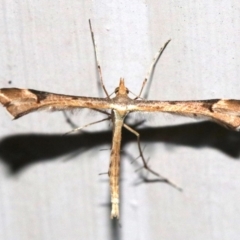An ichneumon wasp at Ainslie, ACT
Identification history
| Enicospilus CNM sp1 | 8 Feb 2020 | jb2602 | ||
| Enicospilus sp. (genus) | 17 Dec 2019 | jb2602 | ||
| Enicospilus sp. (genus) | 16 Dec 2019 | MichaelBedingfield |
Identify this sighting
Please Login or Register to identify this sighting.
9 comments
jb2602
wrote:
17 Dec 2019
These photos were loaded onto iNaturalist and the name was corrected from Netelia to Enicospilus. How do you distinguish between the two from the photos?
MichaelBedingfield
wrote:
17 Dec 2019
See the notes on the page for Enicospilus sp.:
https://canberra.naturemapr.org/Community/Species/Sightings/34056
"Superficially similar to Netelia, but the sclerotized (hardened) flecks in the forewing separate it."
https://canberra.naturemapr.org/Community/Species/Sightings/34056
"Superficially similar to Netelia, but the sclerotized (hardened) flecks in the forewing separate it."
MichaelBedingfield
wrote:
17 Dec 2019
Looking at the sightings of Netelia sp.... some of them may need to be reviewed with this bit of information, for example:
 Netelia sp. (genus) (An Ichneumon wasp) on 28 Sep 2018
Netelia sp. (genus) (An Ichneumon wasp) on 28 Sep 2018
and
 Netelia sp. (genus) (An Ichneumon wasp) on 18 Sep 2019
Netelia sp. (genus) (An Ichneumon wasp) on 18 Sep 2019
and
jb2602
wrote:
18 Dec 2019
I don't know what to look for with the sclerotized flecks (I can only see wing mirror reflection from the flash) but Netelia has a small petiolate cell in forewing, ophionines don't.
MichaelBedingfield
wrote:
18 Dec 2019
I've edited the first photo, and added it back to the sighting, with an arrow pointing to what I thought might be the sclerotized flecks, which seem to be absent from Netelia sp. What do you think?
jb2602
wrote:
18 Dec 2019
I just had a look at a few on iNaturalist and most seem to have that mark so it looks good. Here's one that doesn't though: https://www.inaturalist.org/observations/4084501 (haven't looked at Natelia yet to see if any of them have it).
jb2602
wrote:
18 Dec 2019
Maybe it's the whole clear section in that region of that cell rather than the brown spot?
jb2602
wrote:
9 Feb 2020
E. skeltonii, E. amlipennis and E. samoanus all have very similar fenestras with no central sclerite. E samoanus has an AI index r/p of 0.9 - 1.1 within the range of this specimen and the correct bulge in the throat of the horsehead cell and so is the best fit. See fig 134, Ophioninae of Australia, Gauld 1977. The name Enicospilus samoanus does not exist in any current classification system. It appears to be E. dolosus. Also, Gauld states that it is only in Qld.
Please Login or Register to comment.
Nearby sightings
Location information
- Coordinates 149.152032-35.259269
- Places Ainslie, ACT
Sighting information
- 1 Abundance
- 23 Oct 2019 09:54 PM Recorded on
- jb2602 Recorded by
Additional information
- 12mm to 25mm Animal size
Species information
- Enicospilus sp. (genus) Scientific name
- An ichneumon wasp Common name
- Not Sensitive
- Local native
- Non-invasive or negligible
- Up to 1422.9m Recorded at altitude
- Machine learning
- External link More information
Record quality
- Images or audio
- More than one media file
- Verified by an expert moderator
- Nearby sighting(s) of same species
- GPS evidence of location
- Description
- Additional attributes
















































































































































































































